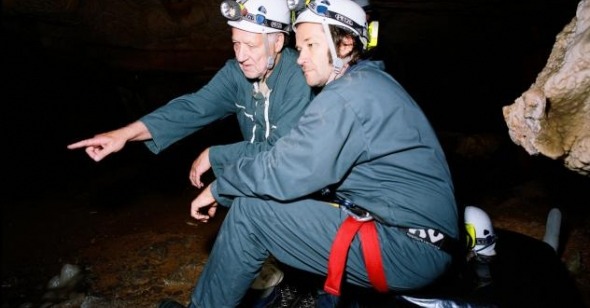The Writing’s on the Wall
By Elbert Ventura
Cave of Forgotten Dreams
Dir. Werner Herzog, U.S., IFC Films
In 1994, three cave explorers probing the Ardeche valley in southern France discovered a passageway blocked by a pile of stones. They cleared the path, entered the cave—and stumbled upon one of the most significant prehistoric art sites ever discovered. On the walls of Chauvet Cave, as it became known, were perfectly preserved paintings of horses, mammoths, cattle, lions, rhinos, even a chimera of a woman with a bison’s head, among other wonders. They are still the world’s oldest known paintings, dating back to the Ice Age, 30,000 to 32,000 years ago.
That glimpse into the first stirrings of “humanness” is the overworked metaphor that animates Werner Herzog’s first foray into 3-D. Taking a camera crew into the restricted recesses of Chauvet, the German director becomes docent to the damnedest gallery you’ve ever seen. “It is as though the modern human soul had awakened here,” Herzog intones. And the subject is indeed worthy of our awe. When Chauvet was discovered, after 20,000 years of being sealed off by limestone, archaeologists and historians had first assumed the paintings to have come much later in the evolution of human art, so sophisticated were their renderings of animals. But when the results of the carbon dating came back, they were stunned to discover that these soulful scrawls were the oldest cave paintings yet discovered.
The paintings seem to have genuinely moved Herzog. Essentially a filmed genuflection, Cave of Forgotten Dreams is the most sober, least wacko movie he’s made in a while. Communing with our ancestors, Herzog imagines the walls as talking screens, whispering something of ourselves from the unimaginable past. Tracking by the undulating cave walls, the camera gives the static images the appearance of movement. Herzog notes that some of the flipbook-like flourishes by the Paleolithic artists seem an attempt at conveying motion, making Chauvet’s walls a “proto-cinema” of sorts. (Indeed, the only non-original footage Herzog includes is a film clip: Fred Astaire dancing, his shadows on the wall.)
A wide-eyed gape at the wondrous, the film on paper seems a natural fit in the auteur’s oeuvre. A plunge into the deepest of abysses, a landscape of limestone and darkness, and a succession of obsessive scientists seem to follow the Herzogian formula of extremes and eccentrics. But—save for a reindeer-skin-clad German archaeologist who can play “The Star-Spangled Banner” on a Paleolithic pipe, and a last-minute postscript involving albino crocodiles that seems almost obligatory—this is actually a pretty square production. Herzog remains, as ever, his own most compelling protagonist, his distinctive voiceover somehow at once self-parody and asset. But the aura of reverence that shrouds the proceedings never quite lifts. Poetic flourishes strain for profundity—“What constitutes humanness?” goes one painfully obvious meditation by Herzog—while oddball curlicues are few and far between. The movie never quite achieves the loopy discursiveness that Herzog’s films are often known for—nor does it even try.
For the most part, it’s an inert performance. The movie lacks an arc, an odd failing for one of cinema’s great raconteurs. Not even the journey into the center of the earth is invested with the kind of meaning and narrative heft that you take for granted in a Herzog movie. Remove Herzog’s face and voice, the 3-D, and that weird excursion in the coda, and Cave of Forgotten Dreams plays like a very good cable-TV documentary—which makes sense, since it was partly financed by the History Channel.
Indeed, at 90 minutes, the movie overstays its welcome. One feels almost impious making such a complaint, but a documentary’s subject, no matter how compelling, shouldn’t inoculate it from criticism. The climactic montages of the paintings, illuminated by lights panning across the walls, as if in mimicry of torches passing by, are indeed captivating. But lingering on them as Herzog does—the climax is as protracted as that of The Lord of the Rings: The Return of the King—only underscores the limitations of his movie. Considering Herzog’s playing it straight, the production can’t help but have a ceiling. Valiant and ardent though it is, Cave of Forgotten Dreams leaves you with that nagging feeling that any documentarian should dread imparting: you sit there willing yourself to share its maker’s experience, but come away thinking that you just really had to be there.
